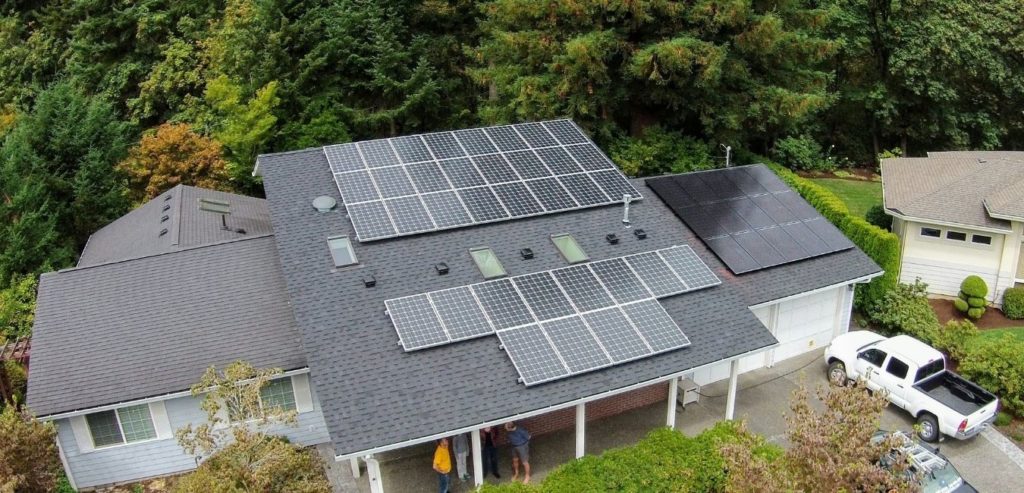Solar Ready Homes
A solar ready home is building a new home with the future installation of a solar energy system in mind. This means that it meets certain characteristics and requirements that will facilitate the installation of a solar energy system and optimize it for maximum solar electricity production. Cash incentives are available to help offset the cost of building homes that are solar-ready.
Building A Solar Ready Home
These are some of the key technical considerations that are necessary for a home to be considered solar ready:
Orientation And Shading
The orientation of the home impacts the functionality of the solar energy system in terms of how much sunlight hits the panels and how direct the angle is. For instance, if a roof is sloped and has a south-facing roof segment, that will be the most optimal location for a future solar panel array.
Additionally, even small amounts of shade can have a huge impact on the system’s Total Solar Resource Fraction. A TSRF of 75% or more is required to qualify for most incentives in Oregon. So ensuring there is a little shade as possible hitting the intended solar array location is essential.
Roof Design And Specifications
The roof must also be constructed in such a way that it can withstand the weight of the solar equipment, which is usually between three and six pounds per square foot. As such, the roof materials must be chosen carefully to hold up to the weight. Minimizing the amount of other equipment and obstacles on the roof will allow for easy installation later on and maximum space for the array. By making your home ready, you reduce the risk of finding potential roof leaks caused by the installation of solar panels on a non-solar ready home.
It’s also important to note whether the roof installation comes with a warranty, as well as whether the warranty includes terms for the installation of solar equipment. Rooftop wind loads should also be examined in advance to determine whether the roof will be able to withstand anticipated winds with the addition of solar panels.
PV Equipment And Installation Considerations
Depending on how the panels will be eventually mounted, contractors may want to consider installing the mounting hardware when they build the roof if the hardware used will be penetrating the roof. Additionally, electrical conduits will need to be routed from the expected solar array location to the home’s electrical panel. Finally, determining in advance where the other solar energy system equipment like the inverter and safety equipment will be mounted will allow for it to be integrated seamlessly into the roof design.

Initial PV System Design Considerations
Even if there are no plans to immediately install a solar energy system, it is still important to evaluate other electrical factors, like whether the home will require an uninterrupted electricity supply (if a resident depends on special healthcare machinery for instance), or whether electricity storage will be necessary. Determining what size of potential solar energy system would be optimal for the home can inform later decisions and other elements of the building design.
Online solar design tools are available to assist homeowners and developers when deciding on the ideal system size and the output potential of the system.
Local Policy Factors
Policies vary by state, county, and even city. It’s important to know your local policies, which can include interconnection standards, net metering policies, system size and aggregate capacity limits, and so forth. These policies will obviously dictate the size and configuration of the potential solar energy system, which can, in turn, have an effect on how the home is planned and built.
Zoning Laws And Permitting Requirements
Local zoning laws and permit requirements can also have an effect on on-site solar development. These laws and regulations should be taken into account while planning and developing the home.
It’s also important to note zoning regulations and their possible future impact on the shading of the roof of the home in question — for instance, whether future nearby construction might throw shade onto the panel array. Solar access laws and historic preservation regulations may also play a role in the development of the home and solar energy system and should be evaluated as well.
Solar Development Assistance Incentive
The Solar Development Assistance Incentive will cover 90% of the cost of doing an energy-efficient design, solar feasibility study, and development that’s necessary for a solar panel installation, up to a limit of $1,800. This incentive is similar to standard solar installation incentives since it works to reduce the upfront cost to the customer by paying the solar trade ally, who then passes on the savings to the customer in the form of overall savings on their energy bill.
In order to apply for this incentive, you will need to complete a Project Enrollment Form and a Solar Development Assistance Incentive application, and then submit the completed forms along with a copy of the contract for services that outlines the cost of the work.
Solar Ready Incentive For New Construction
The Solar Ready Incentive for New Construction is also offered by the Energy Trust of Oregon, and it covers up to 75% of eligible component costs. This includes up to $5,000 for mechanical and electrical specifications, up to $5,000 for structural engineering specifications, and up to $5,000 for Solar Ready construction materials.
In order to qualify for this incentive, your building must meet Energy Trust’s Solar Ready Commercial Design and Construction Requirements, and you must use qualifying Solar Ready components as specified by an approved Energy Trust Solar Trade or Design Ally. All documents must be submitted to the program within 60 days of completion of construction.
Other Incentives
Other incentives may be available for your project. We keep an updated list of solar incentives in Oregon and Washington state that you might be able to apply to and receive. For more information in another state, we recommend contacting a local solar installer in your area.
Ready to Build a Solar Ready Home?
If you are interested in building a solar-ready home or purchasing an existing one, contact us at Sunbridge Solar today.


